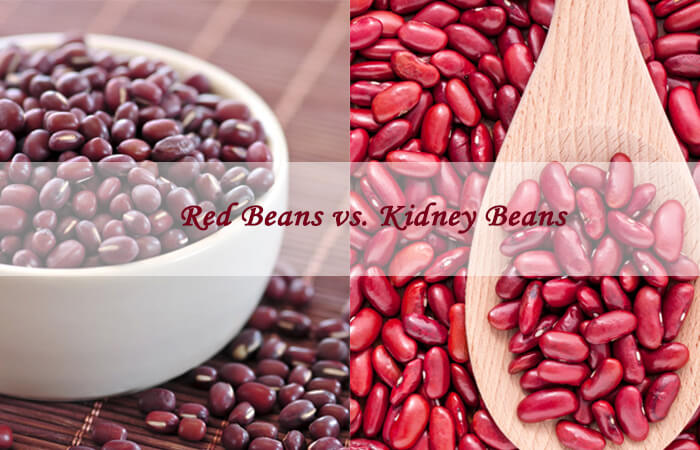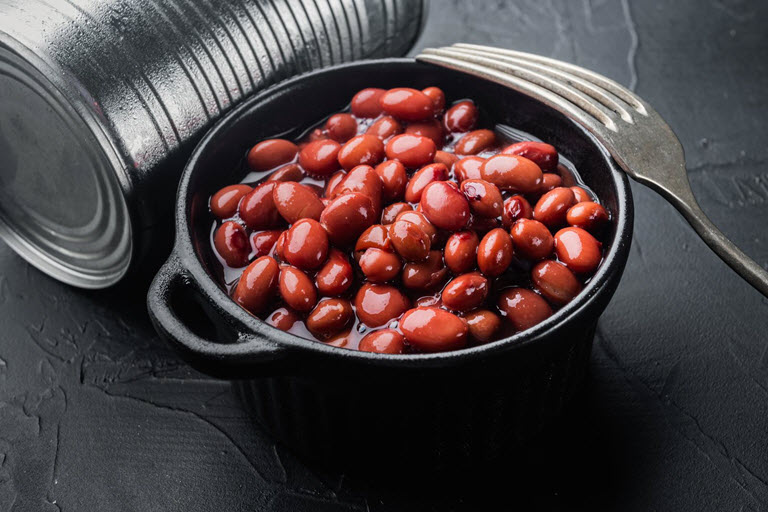There are many bean varieties, and we incorporate them into our daily diets.
It’s common for people to confuse red beans with kidney beans and vice versa. However, kidney and red beans differ in color, texture, and flavor.
Additionally, red beans and kidneys have negligible differences in nutritional values, cooking procedures, and uses.
Continue reading this article to understand the differences between red beans and kidney beans.
Summary of the Differences | ||
Red Beans | Kidney Beans | |
Size | Smaller | Larger |
Shape | Oval-shaped | Kidney shape |
Color | Pink-red | Crimson red |
Flavor | Beany, nutty | Meaty, sweet |
Texture | Smooth and creamier | Rough |
Nutrition | Rich in vitamin B6, calcium, etc. | Lower in fiber, calories |
Uses | Popular in Louisiana dishes | Popular in Mexican dishes |
Table Of Contents
Things About Red Beans You Need to Know
What Are Red Beans?
The name red beans come from the color of the beans. Red beans are small, about half an inch long, oval-shaped, and plump.
One may confuse red beans with Adzuki beans which are relatively similar in appearance and from East Asia.
What Do Red Beans Taste Like?
Red beans are nutty and have a slightly sweet flavor. You will find them creamy and have a smooth texture; hence, they are preferred in many dishes.
What Are Red Beans Used for?
While red beans are a great addition to most menus, they are tasty when you eat them on their own.
Most people eat red beans with rice. Moreover, you can use them with bean salads, soups, and varieties of chili recipes.
Things About Kidney Beans You Need to Know
What are Kidney Beans?
Kidney beans get their name from their shape because they resemble a kidney, an organ in the human body. While many kidney bean varieties exist, only four types are the most common.
These four varieties include; red kidney beans, cannellini beans or white kidney beans, red-speckled kidney beans, and light-speckled kidney beans. It should be easy to differentiate these varieties based on their color.
First, red kidney beans have a deep red color and resemble red beans. However, the distinctive kidney shape makes them unique.
Secondly, red-speckled Kidney beans have a paint-splashed skin comprising white and red colors. They are often referred to as sugar beans. They are preferred to treat anemia [1] in pregnant women because they have high nutrient content.
Thirdly, light-speckled kidney beans have pink, red, or beige color and may come in a round or a long shape.
Finally, white kidney beans get their name from their white color. White kidney beans have a sweet flavor and a high nutrient content.
What Are Kidney Beans Used for?
Typically, kidney beans are prepared with salads, soups, refried beans, and chili menus. You should cook kidney beans fully because they are toxic when raw or improperly cooked.
However, kidney beans contain phytohemagglutinin [2], a toxin that is destroyed through thorough cooking. When cooking kidney beans, it would be best to pre-soak and boil them for 30 minutes.
Differences Between Red Beans and Kidney Beans
While most people confuse red beans and kidney beans, there are various factors that you can use to distinguish the two groups.
The beans’ color, texture, and shape are the basic distinguishing features between the two groups.
Size
Kidney beans are larger than red beans. The small size of red beans is one of their key distinguishing features.
Shape
Kidney beans are shaped like a kidney, hence the name. Red beans are oval-shaped and small, commonly referred to as small red beans.
For most people, it is easier to identify and differentiate the two varieties based on shape.
Color
Red beans are pink-red and look bright. On the other hand, kidney beans are crimson red. It is important to note that some kidney beans come in different colors depending on the variety.
Most people confuse red beans with dark red kidney beans. When unsure, check the size and shape of the beans.
Flavor
Red beans have a beany flavor; depending on the variety, some have nutty undertones. Kidney beans have a meaty taste, and they are slightly sweet.
When cooking with other ingredients, red beans maintain their beany flavor. On the contrary, kidney beans easily absorb the flavor of spices and other ingredients while you cook.
Texture
Kidney beans have thick and firm skin, which appears as a rough texture. Even if you cook kidney beans fully, they will be dense and harder on the inside. On the other hand, red beans are smooth and creamier.
Despite these differences, red beans and kidneys are easily interchangeable in most recipes without a significant change in flavor.
Varieties
Many varieties of beans are red; hence, the name can be confusing. For instance, some kidney beans come in red but are not classified under red beans.
While kidney beans have several varieties, red kidney beans are the ones you will commonly see in the store. White kidney beans are the second most common variety. If you are keen, you will come across black, purple, and other varieties of kidney beans.
The term red beans refer to varieties of small beans, which are red, round-shaped, and commonly used in Mexican and Cajun recipes.
Nutrition
Red beans and Kidney beans have relatively equal amounts of nutrients. A kilogram of kidney beans produces various nutrients, as shown in the following table.
Nutrient | Amount per 1 kg of kidney beans |
Carbs | 230g |
Fiber | 60g |
Fat | 5g |
Proteins | 90g |
Calories | 1.27kJ |
Cholesterol | 0g |
Kidney beans are rich in vitamin B6, calcium, magnesium, iron, and potassium.
When compared to kidney beans, red beans have slightly lower amounts of fiber, calories, and other nutrients. However, you will get relatively similar benefits if you consume either bed beans or kidney beans.
Differences in Preparation
The preparation of red beans and kidney beans depends on the condition of the beans.
First, when using dried red beans, it is best to soak them for at least four hours. Soaking is important to soften the beans and remove the gassy content, which causes bloating [3] in some people.
Second, you can use the quick soak method [4] when in a hurry. After soaking the beans, you should rinse them and boil them for a few minutes. Leave them for about an hour soaking in hot water.
Thirdly, you can consume canned red beans directly from their containers. However, canned red beans have more sodium than dried beans.
It would be best to soak kidney beans in advance to ensure they are safe for consumption. When using canned kidney beans, it is important to rinse them thoroughly.
Moreover, Kidney beans need to boil for at least 20 minutes to eliminate the toxins. You should avoid using a slow cooker because low temperatures are inadequate for removing such toxins. It is easier to use an oven, a pressure cooker or a stovetop.
Substitutes for Kidney beans and Red Beans
Both red beans and Kidney beans have insignificant differences in their nutritional values; hence they are used interchangeably in many recipes. However, you will note differences in flavor and texture.
In many menus, red beans can be substituted with roman beans or cranberry beans, pink beans, and kidney beans.
Moreover, kidney beans can be substituted with pinto beans, red beans, navy beans, and cannellini beans.
Uses and Pairings
Red beans and kidneys have similar uses in cooking. You can often use them in making dips, salads, pasta dishes, soups, chilies, or stews.
However, each variety is best known for making specific dishes.
For instance, red beans are a defining ingredient in Louisiana dishes, including rice dishes. Moreover, red beans are ideal for making dal, an Indian dish.
On the other hand, Kidney beans define the flavor of Mexican dishes, Indian rajma, chili con carne, and some Spanish rice dishes.
Kidney beans are best paired with cumin, bay leaf, fennel, oregano, and savory. If you have red beans, you can use them with cumin, cayenne, paprika, Cajun seasoning, and Italian herbs.
Both red beans and kidney beans work well with onions and garlic.
Shelf Life and Storage
Both red beans and kidney beans have relatively similar shelf lives when canned. They can last for 3-5 days in the refrigerator when cooked.
Moreover, it would be best that you keep dried beans in cool, dry, and cool locations. If you are storing in containers, ensure that they are airtight.
FAQs About Red and Kidney Beans
Can I Use Red Beans Instead of Kidney Beans?
In cases where a menu requires canned beans, most people use red beans or kidney beans. Some people interchange the bean varieties without realizing it.
However, substituting kidney beans with red beans may not be a good idea, especially when you achieve a specific flavor and taste.
Are Red Beans Or Kidney Beans More Preferred To Make Chili?
Most people prefer using kidney beans to make chili. However, when kidney beans are unavailable, you can use red beans and achieve great results.
Kidney Beans vs Black Beans, What’s the Difference?
The most significant difference between kidney beans and black beans is their size and color.
While kidney beans have a grainy texture, red color, and a sweet flavor, black beans are small, black in color, and with a shiny exterior.
Final Thoughts
While many people confuse kidney beans with red beans, the two groups have significant differences. Red beans differ from kidney beans in color, shape, flavor, size, and in texture.
However, kidney beans and red beans have relatively similar nutrient compositions. Many people use red beans and kidney beans interchangeably and some do not notice the slight differences in flavor.
If you do not have red beans or kidney beans, you can use their substitutes, which are relatively similar.
Also Reading


